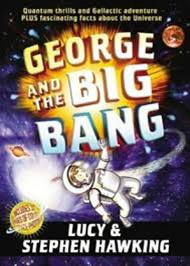George and the Big Bang by L. and S. Hawking
DOI:
https://doi.org/10.20361/G28S36Abstract
Hawking, Lucy and Stephen Hawking. George and the Big Bang. New York: Simon & Schuster, 2011. Print.
This is the third installment in a trilogy about George’s escapades and galactic adventures, though the book provides enough background that it can stand on its own without the reader needing the context provided in the first two books. George is best friends with his neighbour, Annie, whose father, Eric, is an eminent physicist and professor of mathematics. George and Annie secretly use her father’s supercomputer, named Cosmos, not only to answer their questions but also to open windows and passageways into other parts of the world and outer space.
In this story, when Eric and George are observed gallivanting on the surface of the Moon, a special meeting of the Order of Science to Benefit Humanity is called to discuss the consequences of Eric’s actions. The Order is comprised of the world’s leading scientists, and is designed to ensure that science is used for good and not evil. George and Annie must prevent the secret organization, called TOERAG (Theory of Everything Resists Addition of Gravity), from setting off a quantum mechanical bomb at the Large Hadron Collider in Switzerland where the meeting is to take place. The bomb is to be set off just as a very important experiment into the beginnings of the Universe is to be conducted. The group’s intent is to destroy science by killing the top physicists in the world (including Annie’s dad), thereby permanently disrupting scientific investigation. George and Annie encounter much danger and a few close calls along the way.
Black and white cartoon illustrations by Garry Parsons complement the story. Essays about some of the latest scientific theories, such as dark matter and wormholes, factual sections about various astronomical subjects, and colour photographs from space, are interspersed throughout the narrative. They appear when related concepts are presented in the story, though at times they interrupt the flow of the text. The inserts are written in a conversational tone and try to make complex topics comprehensible. However, some subjects will remain beyond the understanding of a young reader. There remains a dichotomy between the fiction and the non-fiction; younger children will appreciate the story, while older kids with an interest in science may learn a great deal about astronomy and physics, but the different elements may not appeal to all ages.
Recommended: 3 out of 4 stars
Reviewer: Trish Chatterley
Trish is a Public Services Librarian for the John W. Scott Health Sciences Library at the University of Alberta. In her free time she enjoys dancing, gardening, and reading books of all types.

Published
How to Cite
Issue
Section
License
Authors who publish with this journal agree to the following terms:
- Authors retain copyright and grant the journal right of first publication with the work simultaneously licensed under a Creative Commons Attribution License that allows others to share the work with an acknowledgement of the work's authorship and initial publication in this journal.
- Authors are able to enter into separate, additional contractual arrangements for the non-exclusive distribution of the journal's published version of the work (e.g., post it to an institutional repository or publish it in a book), with an acknowledgement of its initial publication in this journal.
- Authors are permitted and encouraged to post their work online (e.g., in institutional repositories or on their website) prior to and during the submission process, as it can lead to productive exchanges, as well as earlier and greater citation of published work (See The Effect of Open Access).






